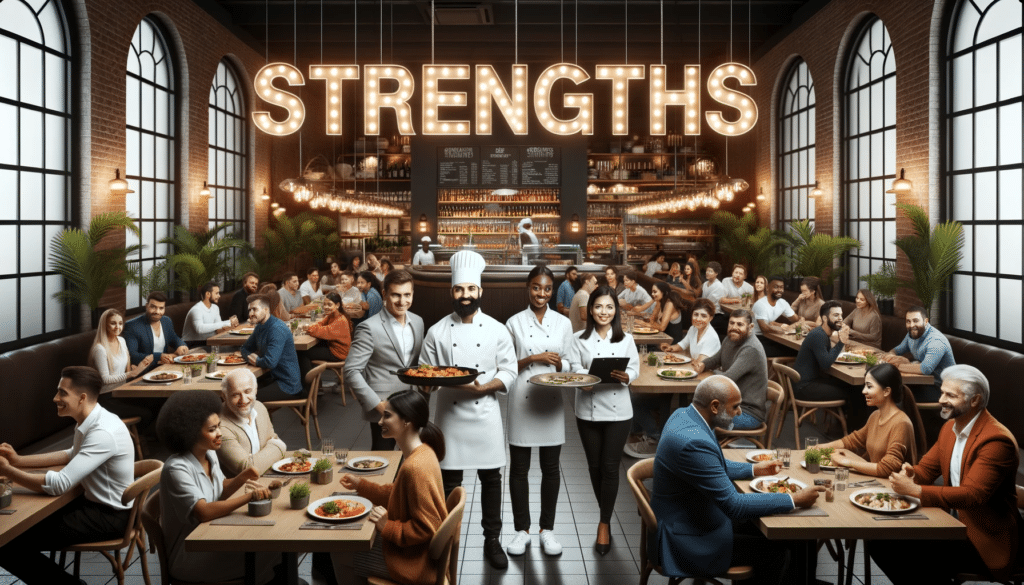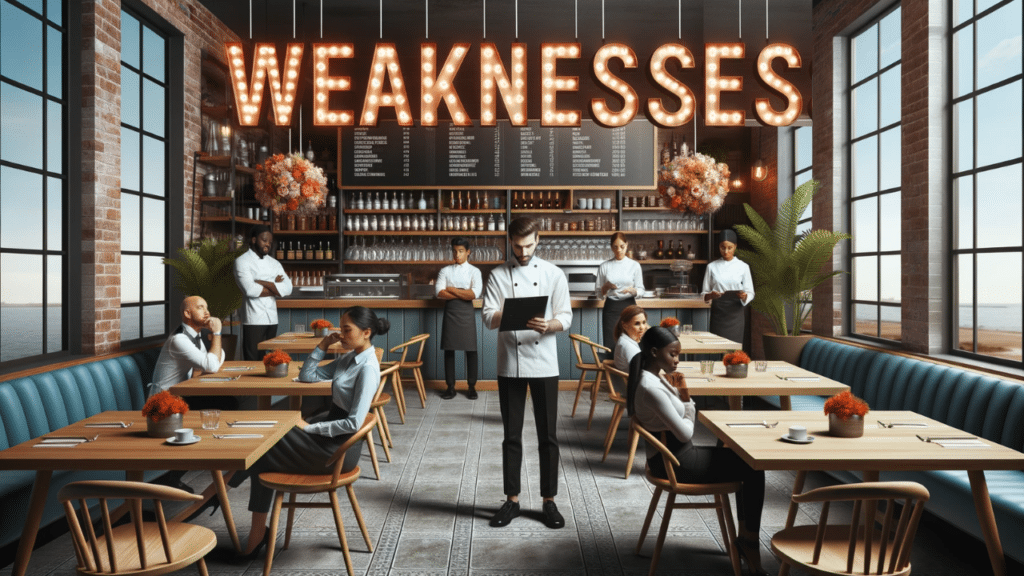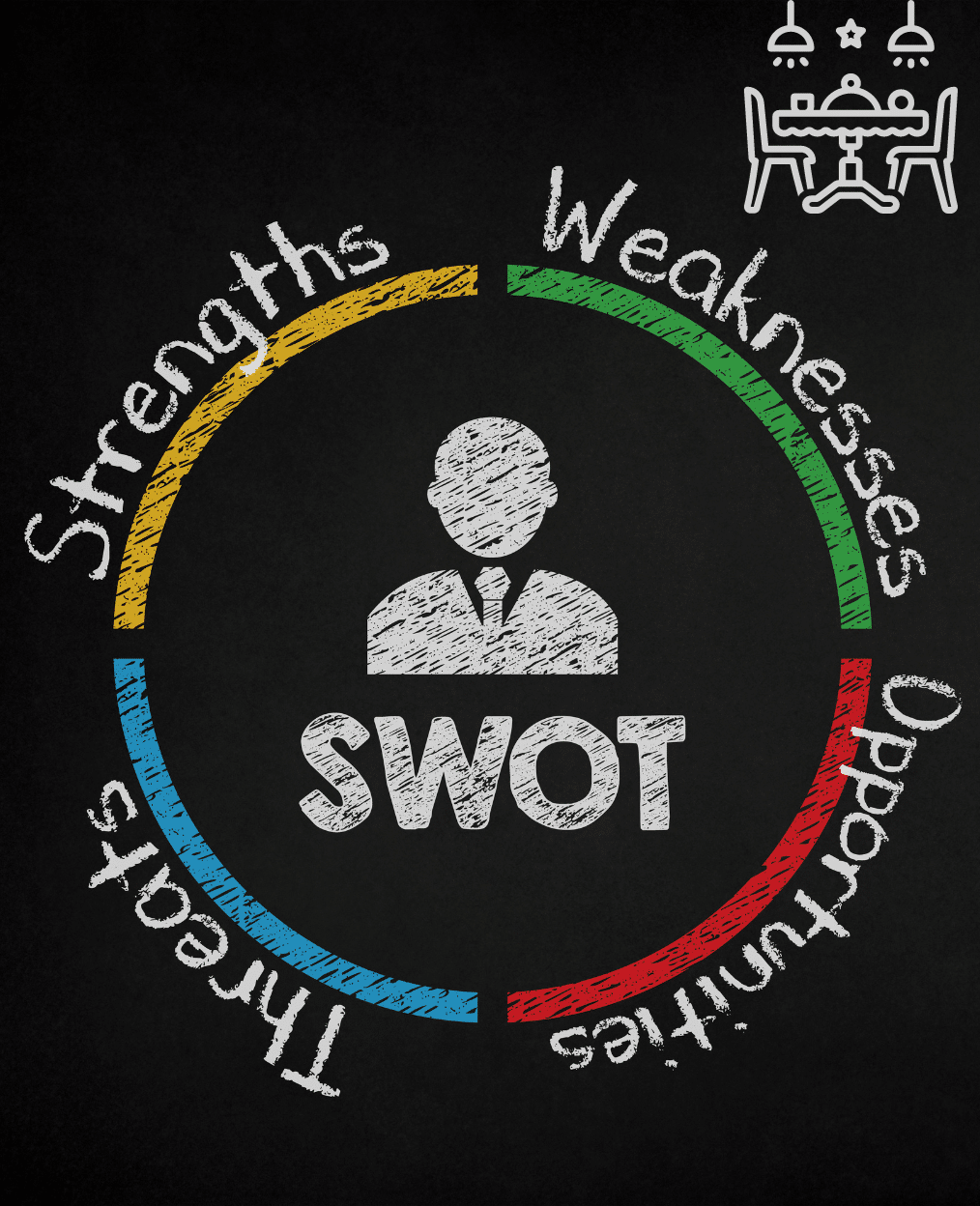A SWOT analysis is a valuable tool for restaurants, as it helps to evaluate their strengths, weaknesses, opportunities, and threats. By conducting a comprehensive analysis of these factors, restaurant owners and managers can identify areas for growth, address potential problems, and make informed decisions to achieve long-term success.
I’m Dr. Loaloa Riad, the lead market analyst and the proud co-owner of GlobeMonitor Market Research Agency. With a rich academic background culminating in a Ph.D. in Strategic Management, I have spent years in the field of business education, imparting knowledge to both undergraduate and MBA students.
My lectures often cover the practical applications of SWOT analysis among other strategic tools, reflecting a deep understanding of the industry’s nuances and complexities.
This article is an extension of my commitment to bridging theoretical frameworks with real-world business challenges, aiming to empower restaurant owners and managers with insights and strategies for thriving in today’s competitive market.
We will explore various SWOT analysis examples for restaurants and discuss how they can be utilized to enhance business strategies and operations.
Using the SWOT analysis, restaurateurs can assess internal factors such as their menu offerings, staff efficiency, and management style, while also taking into account external factors such as market trends, competitor actions, and customer preferences.
Furthermore, this information can be used to create strategic marketing and positioning plans, improve the overall customer experience, and explore opportunities for innovation in menu and service offerings.
SWOT Analysis for Restaurant Key Takeaways
- SWOT analysis helps restaurants identify strengths, weaknesses, opportunities, and threats.
- Evaluating internal and external factors allows for informed decision-making and growth planning.
- SWOT analysis can guide strategic marketing, operational improvements, and customer experience enhancements.
Understanding SWOT Analysis
Fundamentals of SWOT Analysis
SWOT Analysis is a strategic planning tool that evaluates a company’s internal and external environment. It examines Strengths, Weaknesses, Opportunities, and Threats to help businesses understand their current position and identify areas in need of improvement. In the restaurant industry, these four aspects can serve as crucial pillars for making informed decisions and developing a competitive edge.
- Strengths: These are the positive internal attributes that a restaurant possesses. Examples include excellent food quality, superior customer service, affordable prices, or a strong brand identity.
- Weaknesses: Internal aspects of the business that can negatively affect its performance, such as limited seating capacity, high staff turnover, or outdated kitchen equipment.
- Opportunities: External factors that a restaurant can capitalize on, like a growing neighborhood, new food trends, or technological advancements.
- Threats: External obstacles that could harm the business, like competitors, changing consumer preferences, or regulatory changes.
Check our comprehensive market analysis for the restaurant industry
Importance in the Restaurant Industry
In the restaurant industry, SWOT Analysis plays a vital role in assessing a business’s potential and identifying areas for growth. It allows restaurant owners to evaluate their establishment’s strengths and weaknesses, understand market trends, and make informed decisions on how to improve their operation.
By conducting a thorough SWOT Analysis, restaurant owners can uncover opportunities to expand their brand, attract more customers, and improve profitability. For instance, they could identify and capitalize on new food trends, upgrade their menu offerings, or implement customer loyalty programs.
Moreover, understanding the market threats enables restaurant managers to create contingency plans, tackle issues head-on and minimize the impact of unfavorable situations. This proactive approach helps businesses stay competitive, maintain customer satisfaction, and thrive in the industry.
In conclusion, integrating SWOT Analysis into a restaurant’s strategic planning process allows business owners to gain valuable insights, develop effective strategies, and ensure the long-term success of their establishment.
Assessing Internal Factors
When conducting a SWOT analysis for a restaurant, it’s crucial to assess the internal factors affecting your business. These internal factors include strengths and weaknesses that can significantly impact the restaurant’s performance and profitability.
Identifying Strengths

A well-designed menu with a variety of unique and delicious offerings can undoubtedly be considered a strength. By providing a diverse menu tailored to your target market, you can set your restaurant apart from the competition. Another significant strength of any restaurant is the ambiance and atmosphere. Creating a warm and inviting space with tasteful decor and pleasant background music can greatly enhance the customer experience.
Excellent customer service is paramount to a successful restaurant business. A knowledgeable, attentive, and friendly staff can leave a lasting impression on your clientele, increasing the likelihood of repeat visits. Additionally, having a skilled and experienced management team can help ensure smooth operations, establish credibility in the industry, and foster better employee morale.
Common Restaurants Strengths
- Well-designed Menu: A well-curated menu with a variety of unique and delicious offerings is undoubtedly a strength. Not only should it reflect a range of tastes and dietary needs, but it should also adapt to changing food trends and seasons. For instance, incorporating plant-based options can attract a wider audience and reflect a commitment to sustainability. Consider how popular restaurants often have signature dishes that become a talk of the town, driving more foot traffic.
- Ambiance and Atmosphere: Creating a warm and inviting space with tasteful decor and pleasant background music can greatly enhance the customer experience. The ambiance should align with the restaurant’s theme—be it luxury dining, casual eatery, or thematic restaurant—and make customers feel welcomed and immersed in the dining experience. Highlight how successful restaurants use ambiance as a tool to reinforce their brand identity and ensure customer loyalty.
- Excellent Customer Service: A knowledgeable, attentive, and friendly staff can leave a lasting impression on your clientele, increasing the likelihood of repeat visits. Customer service extends beyond serving food; it encompasses managing reservations, handling inquiries, and addressing complaints with grace. Sharing anecdotes of restaurants that have thrived on word-of-mouth due to exemplary service can illustrate this point well.
- Skilled Management Team: Having a skilled and experienced management team can help ensure smooth operations, establish credibility in the industry, and foster better employee morale. They are pivotal in making strategic decisions, managing financial health, and nurturing a positive work culture. Cite examples of how renowned restaurants credit their success to strong leadership and management practices.
Highlighting Weaknesses

On the other hand, weaknesses can reveal areas in need of improvement. For example, high employee turnover can be a significant issue, as it can disrupt regular operations and lead to higher training costs. Addressing this problem by offering competitive wages, benefits, and opportunities for growth can make your restaurant a more attractive workplace.
Another weakness to consider is a lack of operational efficiency in the kitchen, which can lead to slow service or inconsistent food quality. By investing in modern equipment, streamlining processes, and providing employee training, you can help mitigate these issues and maintain a high standard of service for your customers.
By carefully examining internal factors in your restaurant SWOT analysis, you can identify the areas where your business excels and those that require attention. Doing so will enable you to create strategies to capitalize on your strengths and address your weaknesses, positioning your restaurant for sustained success.
Common Restaurants Weaknesses:
- Inconsistent Food Quality: Inconsistency in food quality can be a major downfall for restaurants, leading to a loss of customer trust and repeat business. This might stem from an overextended menu, frequent changes in kitchen staff, or lack of quality ingredients. To overcome this, restaurants can streamline their menus, focus on training, and establish strict quality control measures.
- High Staff Turnover: The restaurant industry is notorious for high turnover rates, which can lead to operational disruption and increased training costs. This often results from low job satisfaction, lack of benefits, or better opportunities elsewhere. To address this, restaurants can invest in employee training programs, offer competitive compensation, create a positive work environment, and provide clear paths for career advancement.
- Limited Marketing Reach: Many restaurants fail to realize their full potential due to a lack of effective marketing. Without a robust marketing strategy, a restaurant might struggle to attract new customers or engage existing ones. Weaknesses might include an outdated website, poor social media presence, or underutilized customer feedback. To combat this, restaurants should consider investing in digital marketing, actively managing online reviews, and engaging with the community through events and partnerships.
- Inadequate Adaptation to Trends: The food industry is continuously evolving with new dietary preferences and food trends. Restaurants that fail to adapt might find themselves losing relevance. This can include ignoring the increasing demand for plant-based options, eco-friendly practices, or technology in dining experiences. Staying informed about industry trends and being willing to innovate the menu or operations can help restaurants stay competitive.
Exploring External Factors
Opportunities in the Market

One important aspect of a restaurant SWOT analysis is exploring external factors that impact the business. A key external factor to consider is the opportunities in the market. Identifying market trends through market research can help restaurants stay ahead of the competition. For example, a growing trend of health-conscious consumers might prompt a restaurant to introduce healthier menu options or cater to dietary restrictions such as vegan or gluten-free.
In addition to market trends, adopting new technology can provide restaurants with a competitive edge. Implementing innovative solutions such as online ordering, tableside tablets for ordering and payment, or using customer relationship management (CRM) software can enhance the customer experience and streamline operations.
Common Restaurants opportunities:
- Expanding Dining Options: With the changing landscape of the food industry, there’s an opportunity to expand dining options to cater to a broader audience. This could include introducing a takeaway or delivery service, adding outdoor seating, or offering meal kits for at-home preparation. Each option caters to different customer needs and can help increase revenue streams.
- Technological Advancements: Implementing new technology can significantly enhance efficiency and customer experience. From online reservations and ordering systems to kitchen automation and customer relationship management (CRM) systems, technology offers numerous opportunities to streamline operations and personalize customer interactions. Additionally, adopting sustainable technologies could attract environmentally conscious customers.
- Menu Diversification: Diversifying the menu to include a variety of cuisines, special dietary options (like vegan, gluten-free, or keto), or seasonal specialties can attract new customers and keep regulars excited. This also presents an opportunity to host special events or theme nights that showcase these unique offerings, creating buzz and attracting different market segments.
- Partnerships and Collaborations: Forming partnerships with local businesses, suppliers, or even other restaurants can open up new opportunities. This might include sourcing ingredients from local farms, collaborating on special events, or creating cross-promotion deals. Such partnerships not only broaden the restaurant’s exposure but also strengthen community ties and can enhance the brand’s reputation.
Potential Threats

Competitors are another significant external factor restaurants must consider in their SWOT analysis. Applying a Porter’s five forces analysis can help identify and address the threats posed by rivals. Restaurants should stay updated on competitor offerings, promotions, and overall performance to make informed decisions on pricing and promotion strategies.
Economic downturns may also present potential threats for a restaurant. During economic challenges, consumer spending on dining out tends to decrease. In such cases, restaurants must consider strategies to manage costs without compromising service and food quality.
Sustainability has become a pressing concern among consumers. Hence, restaurants should be aware of the environmental impact of their operations and attempt to minimize waste and adopt eco-friendly business practices. This approach not only benefits the environment but also appeals to environmentally conscious customers.
In summary, restaurants must continuously analyze and monitor external factors, such as market opportunities, competitors, technological advancements, economic downturns, and sustainability issues, to stay ahead in the industry and make well-informed decisions.
Common Restaurants Threats:
- Increasing Competition: The food industry is incredibly competitive, and new establishments are always opening. A threat for many restaurants is the continuous influx of competitors, potentially offering similar cuisine, lower prices, or more innovative dining experiences. This can split the customer base and decrease individual restaurant’s market share. Keeping a close eye on competitors and continuously innovating or improving the unique selling proposition (USP) of the restaurant is vital.
- Economic Downturns: Restaurants often feel the immediate impact of economic downturns, as dining out is typically one of the first expenses consumers cut back on. An economic slump can lead to decreased customer spending and a lower frequency of dining out. To mitigate this, restaurants might need to adjust their pricing strategies, offer special promotions, or diversify their revenue streams.
- Changing Consumer Preferences: As health, sustainability, and dietary needs become more central to consumer choices, restaurants that fail to adapt to these changing preferences can suffer. This includes shifts towards plant-based diets, demand for organic or locally sourced foods, or an emphasis on environmentally friendly practices. Staying informed and flexible, adjusting the menu, and adopting sustainable practices can help navigate this threat.
- Regulatory Changes: Restaurants face a variety of regulations related to health, safety, employment, and more. Changes in regulations can impose new costs or require operational changes. For example, new health and safety standards might necessitate expensive kitchen upgrades, or increased minimum wage laws might significantly affect labor costs. Staying ahead of regulatory changes and planning for compliance is essential to avoid sudden, impactful surprises.
Strategic Marketing and Positioning
Crafting Marketing Strategies
A restaurant’s marketing strategy plays a crucial role in its success. It’s essential to leverage various channels like digital marketing, social media, and local print advertisements to reach your target customer segments. Effective marketing strategies take into consideration customer preferences, competition, and market trends.
- Identify your restaurant’s unique selling points (USP) and tailor your marketing message to highlight these features.
- Focus on attracting your target audience by crafting compelling promotional offers and advertising campaigns.
- Utilize digital marketing tools such as SEO, SMM, email marketing, and online advertising to boost your restaurant’s visibility online.
- Collect and analyze customer feedback to continuously improve your overall marketing efforts.
Developing a Unique Brand Image
Creating a strong brand image is vital for any restaurant to stand out in the competitive industry. Your unique brand image should revolve around your restaurant’s core values, mission statement, and market positioning. Use the following steps to build a memorable and lasting brand image:
- Define your brand: Clearly articulate your restaurant’s niche, target audience, and values.
- Develop a visual identity: Design a logo, color scheme, and visual elements that represent your brand and appeal to your target audience.
- Create a consistent in-restaurant experience: From the ambiance to the food presentation, ensure that every aspect of your restaurant reflects the brand image.
- Foster an engaging online presence: Establish a strong digital presence by creating a visually appealing website and actively engaging with customers on social media platforms.
A well thought-out marketing strategy and unique brand image are vital in positioning your restaurant for success. Remember to consistently monitor customer feedback and industry trends to adapt and optimize your strategies as needed.
Operational and Financial Analysis
Improving Operational Costs
One of the key aspects of a successful restaurant’s SWOT analysis is identifying areas where operational costs can be reduced. Analyzing labor costs, food waste, and energy consumption can help in determining areas of improvement and efficiency. For example, implementing energy-efficient appliances and lighting systems can significantly reduce utility bills. Moreover, streamlining kitchen processes and reducing food waste by adjusting portion sizes and menu offerings will eventually help the establishment cut operational costs and improve overall efficiency.
In addition to these measures, properly training staff and investing in efficient technology can contribute to lower operational expenses. An adequately trained workforce can improve the level of service and reduce the risk of errors leading to waste. Lastly, keeping a close eye on inventory management can help prevent overstocking and spoilage, which can directly impact operational costs.
Maximizing Profitability
To maximize profitability, it is essential for restaurant owners to monitor variables such as menu prices, profit margins, and overall financial performance. Regularly analyzing menu prices and comparing them against competitor offerings will help ensure that the establishment remains competitive in its market. At the same time, it is crucial to maintain a balance between attracting customers with affordable menu items and achieving a healthy profit margin on each dish.
Financial performance can be enhanced by focusing on increasing revenue streams, such as offering online ordering, upselling techniques, and expanding catering services. These diversification strategies can help boost profitability and provide multiple income sources to sustain the business during challenging times.
It is crucial to regularly analyze the financial performance of the restaurant by reviewing financial statements, such as the income statement and balance sheet. Identifying crucial trends and potential issues early on will allow the business to make swift and informed decisions to optimize profitability and long-term success.
In conclusion, restaurants need to make data-driven decisions that improve operational costs and maximize profitability. By addressing these factors in a comprehensive SWOT analysis, restaurant owners and managers can make informed choices that contribute to the ongoing success and growth of their business.
Customer Experience Enhancement
Evaluating Service Standards
Restaurants must focus on enhancing their customer experience, starting by evaluating their current service standards. Assessing where improvements are needed will result in increased customer satisfaction, which can, in turn, lead to rave reviews. Factors to evaluate include staff efficiency, attentiveness, menu options, and ambiance.
- Staff efficiency: Ensure employees excel at multitasking, possess strong communication skills, and work well together.
- Attentiveness: Staff should respond promptly to customer needs and questions, making guests feel welcome and valued.
- Menu options: Offer a diverse menu to cater to various tastes and dietary requirements, while maintaining consistency in taste and presentation.
- Ambiance: Make sure the restaurant is visually appealing, clean, and has a comfortable atmosphere.
Embracing Feedback and Trends
It is crucial for restaurants to pay attention to both negative reviews and positive ones. Addressing identified weaknesses will help the restaurant improve its overall performance. Some common areas include inconsistent service, limited menu options, or outdated decor.
Embracing trends in customer preferences is also essential, as it may provide new opportunities for growth and improvement. Consider altering the menu to reflect these trends while maintaining their core offerings. Keeping up with changing consumer preferences can result in a more favorable customer experience and increased brand loyalty.
By taking these steps to enhance customer experience, a restaurant will be better positioned to succeed in a competitive marketplace. Continuously evaluating service standards and embracing feedback and trends will not only boost customer satisfaction but also lead to long-lasting, positive growth within the industry.
Innovation in Menu and Service
Expanding Menu Diversity
Innovation in menu and service is crucial for a restaurant to stay competitive and capture market share. One way to innovate is by expanding menu diversity. Offering a variety of menu items can attract a wider range of customers, including those with different dietary preferences and restrictions.
For example, adding a selection of vegetarian options not only caters to individuals following a plant-based diet, but also appeals to customers looking for healthier choices. Also, incorporating international cuisine or regional specialties can provide an exciting dining experience for customers who appreciate global flavors.
A diverse menu should also consider options for various meal periods, such as breakfast, lunch, and dinner, as well as snacks and desserts. By offering choices that cater to different times of the day, the restaurant can accommodate the needs of diners throughout the day and elevate its appeal to potential customers.
Integrating Technology in Service
Leveraging technology can significantly improve restaurant service, streamline operations, and enhance customer experience. One emerging trend in the industry is the integration of technology in service, such as using online ordering systems for takeout and delivery, as this allows customers to place orders conveniently and saves valuable time for the staff.
Other examples of technology integration include:
- Digital menus: Instead of traditional printed menus, digital menu boards or tablets with touchscreen capabilities provide customers with an interactive and visually appealing way to browse and select menu items.
- Tabletop ordering systems: These devices allow patrons to place orders directly from their table, reducing wait times for busy servers and leading to quicker service.
- Mobile payment solutions: Allowing customers to pay their bills through their smartphones can speed up the checkout process and increase overall satisfaction.
In conclusion, innovation in menu and service is vital for a restaurant’s success. By expanding menu diversity, such as offering vegetarian options and unique menu items, and integrating technology in service, including takeout and delivery options, restaurants can remain competitive in the ever-changing dining industry.
Competitive Analysis and Growth Planning
Benchmarking Against Competitors
According to the National Restaurant Association, the U.S. restaurant industry is projected to reach a staggering $997 billion in sales by 2023, highlighting its immense size and significance.
In the restaurant industry, understanding the competitive landscape is crucial for success. This landscape isn’t just shaped by direct competitors, but also encompasses factors including technology, regulations, market trends, and consumer behaviors. One method to evaluate the competition is conducting a competitor analysis, which focuses on understanding and analyzing the competition, their strengths and weaknesses, strategies, products, and overall performance in the market.
By comparing your restaurant with others in the industry, you can identify gaps in your offerings and evaluate potential opportunities for growth. You may employ various benchmarks, such as:
- Menu diversity and pricing
- Customer reviews and feedback
- Staff training and retention
- Marketing strategies
- Technological innovation
Long-Term Growth Strategies
Developing a solid business plan and identifying strategic planning initiatives are essential for long-term growth in a competitive industry. These initiatives should focus on sustainability, profitability, and differentiation in the market. Some possible strategies include:
- Expanding menu offerings: Cater to various dietary preferences and cultural tastes, increasing the restaurant’s appeal to a wider audience.
- Improving customer experience: Invest in staff training, modernize the interior, and optimize the atmosphere to generate positive reviews and word-of-mouth.
- Leveraging technology: Utilize data-driven techniques for menu optimization, customer targeting, and better inventory management. Implement reservation, online ordering, and loyalty systems to enhance the overall experience.
- Strategic marketing: Develop innovative promotions and events to attract more customers or capitalize on seasonal trends and local events.
- Sustainable practices: Implement green initiatives such as waste reduction, energy efficiency, and sourcing from local producers, which might also resonate with environmentally conscious customers.
Growth opportunities can be identified by combining a thorough understanding of the competitive landscape with meticulous planning. By implementing comprehensive benchmarking and long-term strategies, your restaurant will be better equipped to navigate an ever-changing business environment and strengthen its market position.
Frequently Asked Questions
What strengths commonly contribute to the success of a restaurant?
Successful restaurants often have a unique selling proposition, such as a unique menu or ambiance. Location can also be a strength, as a restaurant may be close to a highly trafficked area. Furthermore, high customer satisfaction, consistent food quality, and an experienced staff contribute to a restaurant’s success.
Can you identify common weaknesses in the restaurant industry?
Common weaknesses faced by restaurants include high employee turnover, inconsistent service, limited menu options, and outdated decor. In addition, some restaurants struggle with issues such as limited on-site parking, which can negatively impact customer satisfaction.
What external threats should a restaurant be aware of in its market?
Restaurants need to be aware of the competition in their local area, price sensitivity of their customers, and potential fluctuations in food costs. Other external threats may include changing consumer preferences, economic downturns, and regulatory changes that could affect the restaurant’s operations.
Could you provide examples of opportunities restaurants might explore for growth?
Opportunities for growth may include offering new menu items, diversifying revenue streams (e.g., catering, delivery services), and capitalizing on trends in the industry, such as sustainability or healthier food options. Restaurants can also consider expanding their presence through additional locations or franchise opportunities.
How do external factors in the food industry affect individual restaurant operations?
External factors such as food trends, consumer preferences, and regulatory changes can have a significant impact on a restaurant’s operations. A restaurant that adapts to changing consumer preferences and quickly responds to industry trends may be better positioned to succeed than a competitor that fails to adapt.
In what ways can a SWOT analysis benefit a restaurant looking to improve its business strategy?
Conducting a SWOT analysis helps a restaurant identify its strengths, weaknesses, opportunities, and threats. By addressing weaknesses and leveraging strengths, a restaurant can develop a more effective business strategy. Furthermore, understanding external threats and opportunities can help a restaurant adapt to market conditions, capitalize on trends and growth opportunities, and ultimately improve its overall performance.
- SWOT Analysis for Restaurant Key Takeaways
- Understanding SWOT Analysis
- Assessing Internal Factors
- Exploring External Factors
- Strategic Marketing and Positioning
- Operational and Financial Analysis
- Customer Experience Enhancement
- Innovation in Menu and Service
- Competitive Analysis and Growth Planning
- Frequently Asked Questions
A quick overview of the topics covered in this article.
Latest Posts
December 21, 2025
December 21, 2025
Subscribe to our newsletter
Get valuable insights and business guidance sent to your email.













